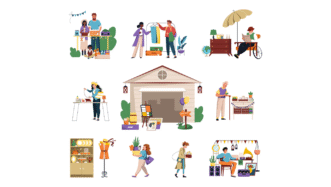LESSON OVERVIEW
In this grammar lesson students discover different verb patterns by doing a friendship quiz. To practise gerunds and infinitives, students will also express their views on different aspects of friendship.
B1 / Intermediate60 minStandard LessonUnlimited Plan
LEAD‐IN & QUIZ
The worksheet starts with a short discussion. Students answer three questions about friendship which lead to a friendship quiz. The quiz consists of ten multiple choice questions about different life situations involving friends and is meant to answer the question: ‘Are you a good friend?’. From the beginning of the lesson students are exposed to different verb patterns (e.g. How would you suggest making new friends?) and eventually, they comment on the quiz results.
GRAMMAR PRESENTATION (GERUNDS AND INFINITIVES)
In the next part of the lesson, students take a closer look at the quiz sentences and focus on the highlighted verbs (e.g. enjoy, fancy, avoid). Their task is to decide whether they are followed by a gerund (+ing) or an infinitive with to. Once the verbs are divided into two groups, it’s time to put the rules into practice. Students look at eight gapped sentences containing previously studied verbs and have to add other verbs from a box, keeping in mind their correct forms (gerunds or infinitives). This controlled practice exercise is followed by a more personalised one, in which students finish the sentences so they are true for them (e.g. My friends don’t mind…). Finally, students move on to the last practice stage which is a group activity. They use eight prompts (there are three different sets) to form questions related to friendship. Next, they ask and answer each other’s questions and exchange opinions about different aspects of friendship.
WORKSHEETS
Subscribe to unlock these and many other Standalone lesson lesson plans with the Unlimited plan
Subscribe














I LOOOOVE this class and my students thoroughly enjoyed. GREAT WORK! Thanks a million.
Great to hear that! Thanks for your comment!
The exercise in which you have to divide the verbs into -ing or inf is far too easy because you show the sentence with it on there, it would be better to show the verb first on its own and try to get the student to guess, then if they can´t, then show the sentence to help them further with the answer. I just did the entire lesson in 24 mins, apart from the questions at the end with a B1 student, it is in no way a 75 min lesson in my opinion!
I would also really like to see slides 16 through 23 separated to give the participants more of an opportunity to think about the answers before they are revealed.
Thanks in advance!
If you use the Present mode in Google Slides, the answers are animated so students won’t see them until you press space or left-click (each point is animated separately so one click = one answer).
Okay, we might have overestimated the time but still we think it should take around 60 minutes. Obviously, that’s going to be true for a group setting, doing all the tasks (incl. the questions at the end) and the fact that students are somewhere on A2/B1 level. It’s an estimation, of course, and it all depends on how talkative your students are and how much time you want to give them to talk and practice using the verb patterns. In terms of identyfing a verb pattern, we figured that for A2 or lower B1 students, it’s enough to find it in context. Of course, you could just ask them to guess without going back to the quiz.
This may be a valid point. However, the columns are a good basis for further tasks, either free-speaking work or free question building work with QA sessions…
I registered unlimited plan using Facebook but now I can’t remember my password and I don’t have acceso to worksheets
If you registered via FB, then just log in using the same Facebook account (no password required). Alternatively, reset your ESL Brains account password through this link: https://eslbrains.com/my-account/lost-password/ where you need to put your email address (in your case the same as you used for your FB account).
Superb lesson plan!
Though some of the alternatives in the questionnaire seem a bit bland, this is exactly what provides food for thought and discussion.
Thanks for integrating the politically correct usage of they/their ind the questionnaire insteda of he or her when referring to a friend.
This is also a good point to make while teaching this lesson…
GREAT!!!!
I loved!! very good for beginners
Great to hear that! Thanks for the comment!
It is a great lesson and it did use 60 min of my class time. Also regarding the sentences showing up and making the answers easy in the category practice, I solved that by writing each group of verbs on the board and having them think through when they were done I would reveal the sentences. Then have them look at the board for the next group of words and so on. That solved that concern and all I had to do was write some words on a board.
Thanks for taking the time to comment and sharing your idea with us!
Very nice lesson, however, I miss the grammar explanation (maybe with a video or an infographic, something visual) so that students can then practice
Thanks for the comment! With this lesson, we want students to discover and practise the verb patterns in speaking, so that’s why there is more focus on it rather than on rules.
Excellent lesson on an essential grammar point. Great job!
Thanks 🙂
Hi, can I ask why the files to the hyperlinks get deleted? I have already saved this file and many others on my google drive but as the role plays etc get deleted I have to come and download the google slide again. I get this message on the old ones ‘Sorry, the file that you’ve requested has been deleted.’
Hi there! We update the links regularly and so I recommend saving the lesson page and not the link to the e-lesson plan. This way you will always access the latest version of the file. BTW we don’t do that with roleplays very often, though, so please email me and tell me which role play stopped working for you so that I can deal with it.
GREAT LESSON, LOVED THE QUIZ ! THANK YOU.
Happy to hear that 🙂